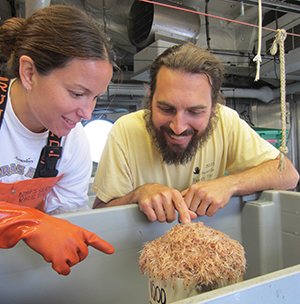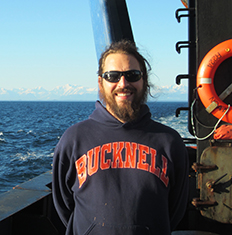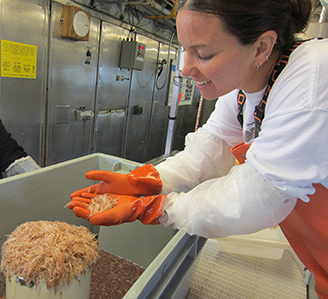
AFSC News
March 1, 2016
Scientists Study Euphausiids (Krill) in Alaska: Fish Food and Indicators of Ecosystem Health
 |
| Scientists looking at krill catch. Photo NOAA Fisheries |
Alaska has an abundance of marine life including whales, dolphins, seals and fish. In fact, the walleye pollock resource supports the largest fishery in the U.S.
Why is this? Availability of prey has a lot to do with it.
Check out our Fish Food Tweet Chat
held on Tuesday, March 8, 2016 with NOAA Fisheries research biologists, Patrick Ressler and Kirsten Simonsen, the lead authors on this important new study.
More About Patrick Ressler
 |
|
| NOAA Fisheries research biologist Patrick Ressler. Photo NOAA Fisheries. |
|
Patrick works with the Alaska Fisheries Science Center?s Midwater Assessment and Conservation Engineering program. His research interests include understanding how physical oceanographic features influence the distribution of zooplankton, fish, and other higher predators, applying acoustic field methods to the study of patterns in zooplankton and fish abundance and distribution, developing acoustic indicators for use in fisheries management and stock assessment, and learning how marine ecosystems respond to climate change.
Prior to joining NOAA Fisheries, Patrick attended Bucknell University in Lewisburg, PA (B.A., Biology, 1996), and after spending a semester abroad learning oceanography and nautical science aboard a large sailboat, he came home wanting to go back to the ocean. After learning about biological oceanography, acoustics, and marine mammals at Texas A&M University in College Station, TX (Ph.D., Oceanography), he spent a year as a post-doc at the Hatfield Marine Science Center in Newport, OR studying oceanography and euphausiids (?krill?) of the California Current.
More About Kirsten Simonsen
 |
|
| NOAA Fisheries research biologist Kirsten Simonsen. Photo NOAA Fisheries. |
|
Kirsten also works with the Alaska Fisheries Science Center?s Midwater Assessment and Conservation Engineering program. Her primary interests are in fisheries ecology, examining the roles of habitat and the environment on the ecology of marine fishes.
Prior to joining NOAA Fisheries, Kirsten went to Roger Williams University to pursue a degree in Marine Biology (B.S., Marine Biology, 2001). She spent a year after college working at the University of Maryland Chesapeake Biological Laboratory, before moving back to New York to work for a non-profit marine biological field station, teaching high school interns and various school groups about marine ecology. In 2004, she moved to Baton Rouge, Louisiana to pursue her graduate degree in the Department of Oceanography and Coastal Sciences. Here, she studied the effects of an inshore artificial reef on the distribution and feeding ecology of estuarine fishes.
Read more about Alaska Fish Food.
Journal article: Spatio-temporal distribution of euphausiids: an important component to understanding ecosystem processes in the Gulf of Alaska and eastern Bering Sea
Poster presentation: Surveying euphausiid abundance to understand the central Gulf of Alaska ecosystem (AMMS 2016)
For more information please contact Marjorie Mooney-Seus,
206-526-4348 (office), 774-392-4865 (cell)
|